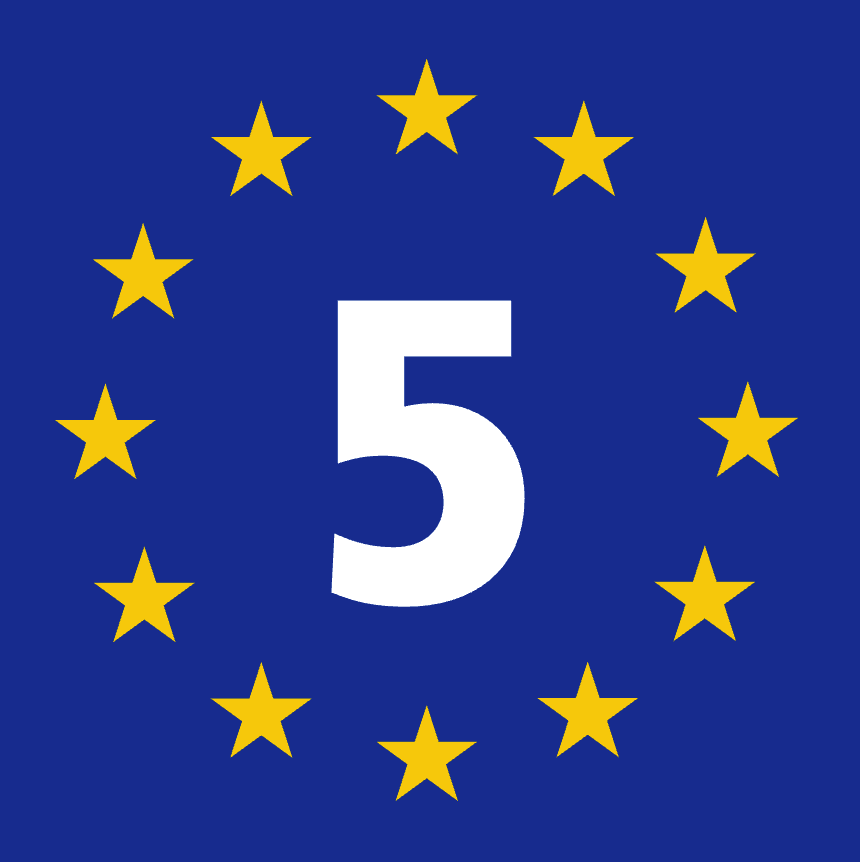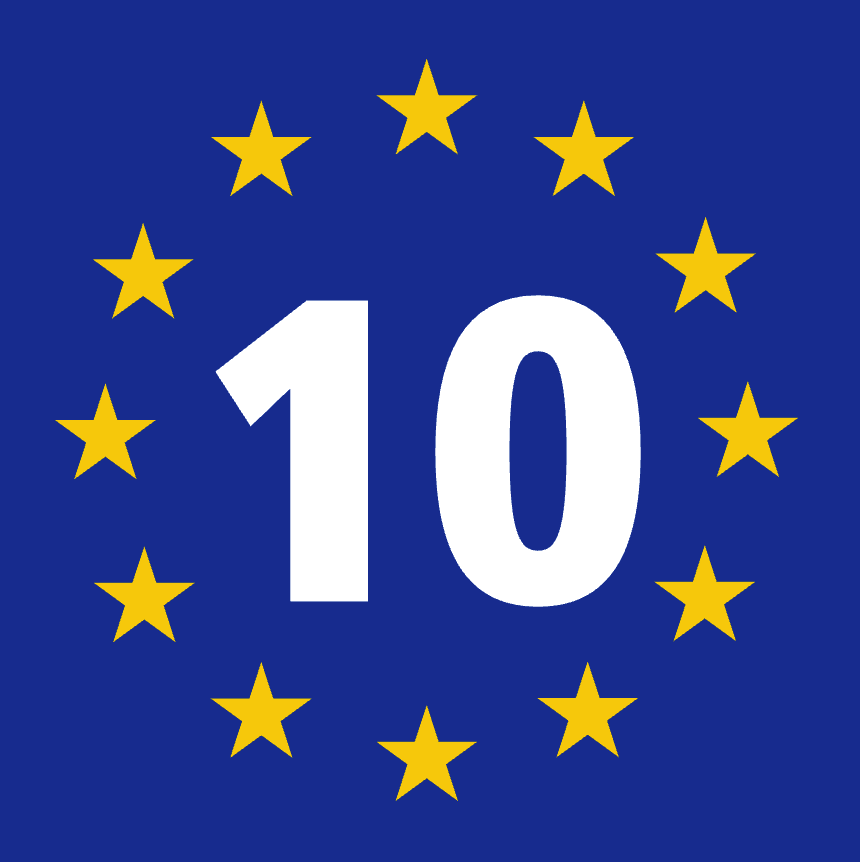Cycling Day 10:
Wednesday 28th July: Dabo to Strasbourg
3 hours 14 minutes in the saddle, 65 kilometres
Cycling down the mountain from Dabo & the Porte des Vosges could have been the most enjoyable ride so far; the long decent through deeply forested hills, opening out onto a plane full of colour, both from the crops in the fields and from the pretty villages with their brightly painted houses and window boxes and finally a dedicated cycle route along disused railway tracks and an overgrown canal which brought me right into the centre of Strasbourg itself.
Unfortunately for all but a few cherished minutes as I started to cycle along the canal, it rained heavily all morning. I had hung around the campsite that morning as long as reason dictates that a passing shower might stop but it was no passing shower so I plunged head first into the watery cycle that was waiting for me. A field of sunflowers summed up my mood; their heads were hung, facing the ground having given up on their search for the sun in a depressing reflection of the morning’s weather. I paused my journey for breakfast in Romanswiller where I cowered under an awning outside the boulangerie wondering where the sunny summer weather had gone.
Strasbourg is a city I had wanted to visit for many years. Tucked away as it is on the far eastern border of France it is a destination in itself (unless you happen to be cycling along the Eurovelo 5 that is) so I had never happened to stumble upon it in my numerous years of criss-crossing France. About the only thing I knew about the city was that it is home to the European Parliament. Well, one of them at least, and to be fair, it was the first one. Here is not a place to debate the utter stupidity of there being two but as a European taxpayer I’m not going to let the opportunity pass to do just that. The parliamentarians wanted to be closer to the heart of power but the French were having none of that so they lobbied successfully for the original parliament in Strasbourg be retained and it is now enshrined in European legislation that twelve plenary sessions lasting four days each must be held there every year. To seal the deal in stone and mortar, or rather glass and steel, the former French president, Jacques Chirac had a replacement parliament building built at a cost of 300 million euros. And which continues to incur ‘duplication costs’ of 200 million euros per annum. According to a BBC report shortly after the building was opened in 1999, door frames had to be removed to move the office furniture into the building (although it doesn’t make clear who was to blame; the people designing the doors or those ordering the furniture), and luxury showers fitted into the MEPs’ offices costing over 8,000 euros each were never used because the politicians are not allowed to stay overnight in their rooms for security reasons. If you think these were just teething problems, in 2008, part of the ceiling above the debating chamber collapsed. No one was in there at the time (unlikely if you think about it as twelve sessions of four days each leave the place empty for 317 days a year), although if they had, the damaged ceiling would have fallen on the heads of eurosceptic MEPs. You couldn’t make it up! And I’m a fully-paid up member of the European Union fan club.
Back to the cycling. To be honest I was a little disappointed on arrival. Clearly a time of biblical downpours is not the best moment to arrive anywhere and the suburbs looked drab and dirty. I meandered my way into the centre following signs for ‘centre ville’ whenever I could see one. There was an extensive system of cycle paths but as in many French cities there was also an extensive system of improvement works taking place (where do they get the money from?) so following the cycle routes was a bit hit and miss.
I eventually found myself in Place Kléber which appeared to be the central square, plonked myself under the canvas of a covered terrace in front of one of the numerous bars in the square and dripped. Two demi pressions later, I decided that I better make an effort to find somewhere to sleep. Although I had passed a campsite in the suburbs, I had always planned to use hotels when in big cities, as I had done back in Luxembourg and saw no reason to not do so here. My guide book mentioned a few interesting establishments, which, had I not been feeling as though I had been through the rinse cycle in a washing machine, I might have investigated. As it was, I just wanted to dry off and as soon as I saw a sign for the budget hotel Ibis and a reasonable price advertised outside, it was a done deal. Reggie was allowed to join me in my room and as soon as we were both inside and the door shut, I slumped on the bed and dozed.
I woke around an hour later and showered without managing to slip on the bathroom floor (Ibis don’t do shiny floors in bathrooms thank goodness). My next task was to sort myself out with some clean clothes. The lady at the reception desk sent me off in one direction to find a laundrette but when I arrived there the place was boarded up so I returned to the hotel just a little dejected. At least it had stopped raining. The same lady then sent me off in the opposite direction to find another laundrette which was about twice as far away as the first. And it started to rain again, chats et chiens, as the French don’t say. I must have passed for a tramp as I swam along the streets wearing a pair of shorts and a white t-shirt that was anything but white and which was destined for the bin once I had alternative clothes to wear and with a pull string bag slung over my shoulder containing all my dirty clothes.
Laundrettes don’t tend to be in the most fashionable parts of town; I couldn’t see a Gucci or Prada down the Boulevard de Lyon; there were however quite a few kebab shops, a dodgy hotel with an official accreditation from 2002 but with the stars taped out and lots of shifty looking characters who kept popping into the fishing tackle shop next door to the laundrette. None of them came out with anything resembling a fishing rod. My initial poor impression of Strasbourg was not being enhanced. However, on the positive side of things, the laundrette ticked all the boxes or perhaps more appropriately pushed all the buttons. I whiled away the time reading the numerous signs and instructions that you find in laundrettes worldwide and before you could say “we accept no responsibility for loss or damage to your clothes” (in French of course), I had a dampish pile of freshly laundered clothes. Fantastic! Even better, it had stopped raining again.
As I made my way back to the hotel, I forced myself to try and see a different, more welcoming side to the city, and I began to spot it through the sporadic glints of sunshine. My mood was also improved as I quickly found and bought a new white t-shirt and blue polo shirt for an amazingly cheap 15€ from H&M in the shopping centre next to the hotel, hung all my other clothes around the room to dry properly, put on my new outfit and set off into town to explore.
The Ibis Hotel was just next to the canal on the north-west side of the city. Apart from the European Parliament being housed in the city, I did actually know two other things about Strasbourg; that is was on the Rhine and that Germany was on the other side of the river. Well, I was correct about the Germany bit but not quite correct about Strasbourg being on the Rhine. The heart of the city is actually some four kilometres east of the river and is built on a kind of island formed between the canal and the River Ill. My map indicated that the area around the Cathédrale de Notre-Dame might be worth exploring so I headed there, back through Place Kléber and towards the south-east. It was late afternoon so I guessed that I would be better off exploring inside the cathedral the following morning when I had more time. So instead, I simply sat below the rose window opposite the main door of the cathedral and had a coffee. As I looked up at the building looming above me I could see two remarkable things. Firstly the building itself. Bathed in the evening sunlight it had taken on a strikingly orange hue and the whole facade was a riot of detail and intricacy, especially the long thin columns that supported the balconies under each of the arched windows. It looked a bit lopsided however. Well, more than just a bit. The cathedral only has one tower, the one on the south was planned but never built. And here’s a fascinating fact; for over two hundred years, from the mid 17th century to the late 19th century, the tower that I was looking at was the tallest building in the World. The other remarkable thing that I could see? The deep blue sky behind the cathedral itself. Not a cloud to be seen. Was this a good omen for the days to come?
I exchanged messages with my friend Claus in Stuttgart and we arranged to meet at midday the following day on a bridge over the canal in the area called La Petite France. With my day’s work done, I slowly made my way back to the hotel and ate in an adjacent restaurant looking out over the canal. My second full day off the saddle beckoned.
(c) Andrew Sykes 2011















1 reply »